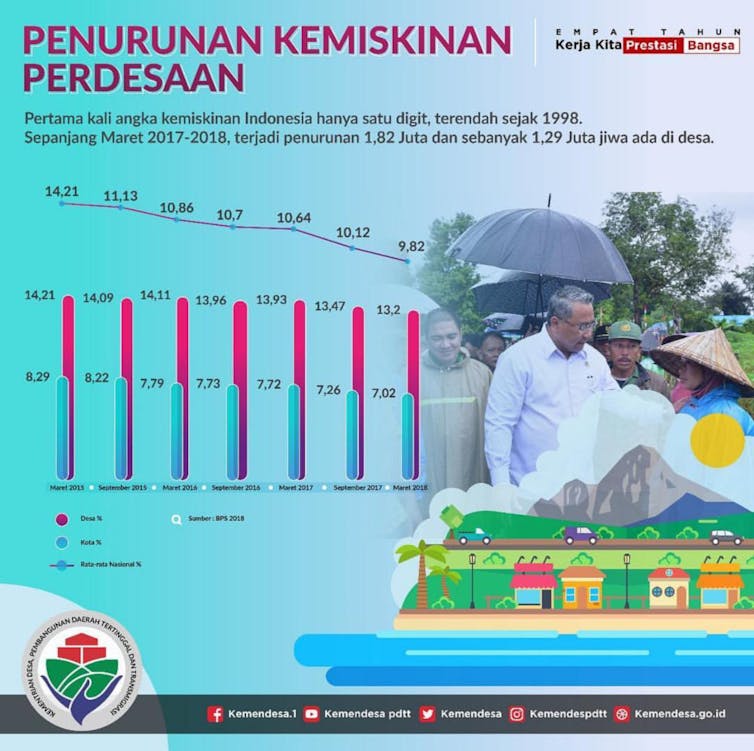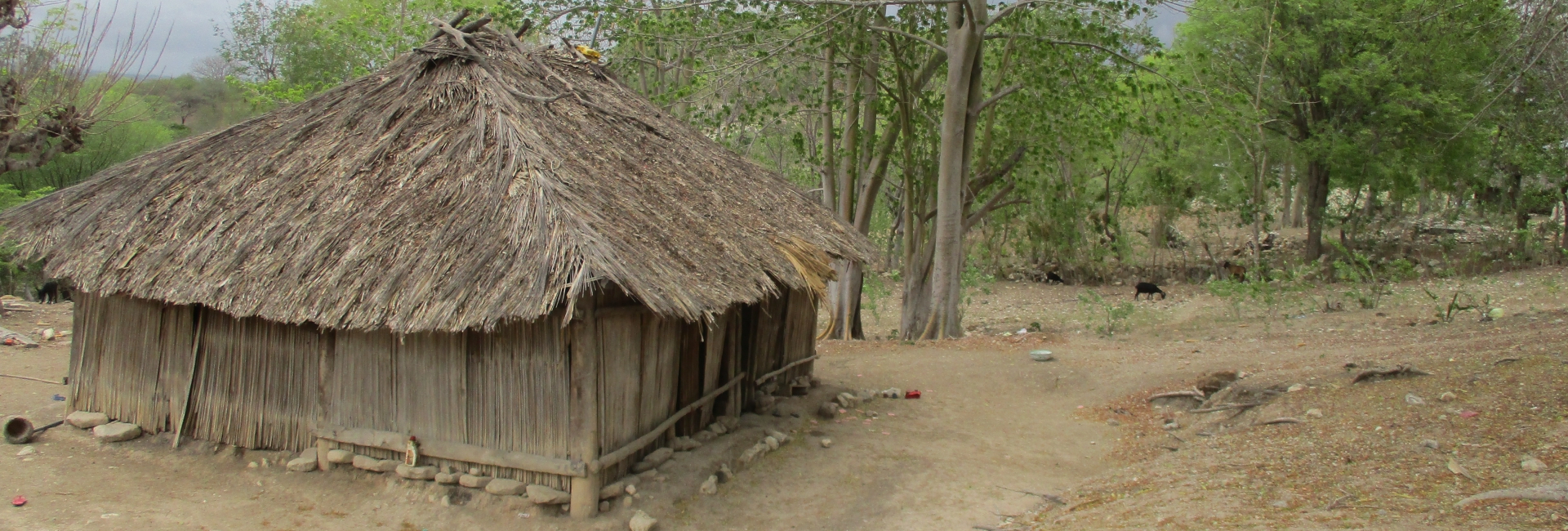.
This article is re-published from The Conversation Indonesia (TCID)
.
On November 5 2018, Indonesia’s incumbent presidential candidate Joko “Jokowi” Widodo released a statement claiming that the rate of poverty in rural Indonesia has declined at twice the poverty rates of cities.
But is it true?
Jokowi’s response
The Conversation contacted the Presidential Staff Office to confirm and request an explanation for Jokowi’s claim. They explained that his statement was made based on data from the Ministry of Villages, Disadvantaged Regions and Transmigration, citing reports from the Central Bureau of Statistics (BPS) on poverty rates from March 2017 to 2018.

Data showing the decline of poverty in rural areas. BPS 2018
To verify the accuracy of Jokowi’s claim, The Conversation asked economic researcher Ridho Al Izzati from SMERU Research Institute.
Analysis
Before testing that claim, firstly, we must understand the indicators the Indonesian government uses to measure poverty. These measures were introduced by economists James Foster, Joel Greer and Erik Thorbecke in 1984 to calculate poverty rates.
Those indicators include:
-
The poverty rate, the percentage of people living below the poverty line as compared with the total population. From this indicator we can figure out the number of poor people.
-
The poverty gap rate measures how far or how deep is the level of income of the impoverished population from the poverty line. This indicator is measured by calculating the average distance between the income of the poor and the poverty line. The further they are from the poverty line, the more impoverished they are.
-
The poverty severity rate measures income inequality among poor people. This indicator is the average of the squared poverty gap. This calculation is made to identify the distribution of income among poor people and how far the most impoverished is from the people who are closest to the poverty line.
Although the BPS uses all three indicators to measure poverty, the first approach is most frequently used because it’s considered the easiest and the most popular among policymakers.
If we use all three approaches to evaluate Jokowi’s statement, then his statement is not exactly accurate. Although calculations of the number of poor people along with the depth and severity of poverty are correct, the percentage of impoverished people is not accurate.
The percentage of rural poverty in March 2017 was around 13.93% and in March 2018 it became 13.2%. This means the rural poverty rate fell by 0.73 points. At the same time, urban poverty rates decreased by 0.7 points from 7.72% in March 2017 to 7.02% in March 2018. Thus, there is no significant percentage difference between the decline of poverty rates in the city and rural areas.
The number of poor people in rural villages decreased 1.29 million from 17 million people in March 2017 to 15.8 million people in March 2018 while the number of impoverished people in urban cities decreased by 500,000 people from 10.6 million in March 2017 to 10.1 million in March 2018. So, it is true that the reduction in the number of impoverished people in rural areas is twice the number of those in the cities.
Moreover, the rural poverty gap rate has declined by 0.12 points from 2.49% in March 2017 to 2.37% in March 2018. Urban poverty rates declined by 0.07 points from 1.24% in March 2017 to 1.17% in March 2018. This means that rural poverty gap rate did decline by almost twice the rate of the decline in urban poverty depth.
For the poverty severity rate, numbers from rural areas have decreased by 0.04 points from 0.67% in March 2017 to 0.63% in March 2018. In urban areas, poverty severity has declined as much as 0.02 points from 0.31% in March 2017 to 0.29% in March 2018. This implies that the decline in rural poverty severity is twice as much as in the city.
Although most of Jokowi’s statement are statistically valid, if we aim to assess his accomplishment in eradicating poverty, it would be best to measure this from the beginning of his administration, from September 2014 until March 2018 (the most recent data available).
Thus, I offer an additional analysis of Indonesia’s poverty rates from the beginning of Jokowi’s time in office. My analysis based on data provided by the BPS exhibits a different fact.
When we look at the period between September 2014 and March 2018, the decrease in urban poverty percentages are actually bigger when compared to numbers from rural villages.
The rural poverty rate in September 2014 (a month before Jokowi’s inauguration) was 13.76%. If we compare this with the numbers from March 2018, it decreased by 0.56 points.
During the same period, the rate of decline for urban poverty is actually higher than rural levels. Urban poverty rates declined by 1.14 points from 8.16% in September 2014 to 7.02% in March 2018.
Graph 1: The percentage of poverty between September 2014 and March 2018. During this period, the rate of poverty experienced a rise in March 2015 but has steadily declined since then.
Source: BPS 2018
However, the decrease in the number of poor people in villages is indeed greater than in the cities during Jokowi’s time in office.
During Jokowi’s administration, the number of impoverished people living in rural areas declined by as much as 1.5 million people from 17.3 million in September 2014 to 15.8 million in March 2018.
During the same time frame, the number of poor people in cities declined by 200,000 people from 10.3 million to 10.1 million.
Graph 2: The number of people struck by poverty from September 2014 to March 2018. The number rose briefly in March 2015. Afterwards, it declined before rising back up on September 2016 to March 2017. Instead, the number of impoverished people only rose on March 2015 and steadily declined significantly afterwards.
Source: BPS 2018
For the rate of poverty gap during Jokowi’s administration, rural numbers actually increased by 0.12 points from 2.25% to 2.37%.
The urban numbers for poverty gap declined by 0.08 points from 1.25% in September 2014 to 1.17% in March 2018.
Graph 3: Poverty gap.
Source: BPS 2018
The similar trend, in which the decline rate of poverty numbers in the cities is higher than in the villages, also occurs in the poverty severity rate. The rate of rural poverty severity has increased by 0.06 points from 0.57% in September 2014 to 0.63% in March 2018. The urban poverty severity rate declined by 0.02 points from 0.31% in September 2014 to 0.29% in March 2018.
Graph 4: Poverty severity rate.
Source: BPS 2018
The above analysis is made by taking the dynamic welfare of the population into account. A household can escape poverty at a certain year but at any time it can return to poverty. This phenomenon is known as vulnerability.
Conclusion
As a conclusion, it is valid to say that between March 2017 and March 2018, the number of impoverished people in rural areas did experience a bigger drop than those in the city. But the percentage of poverty rate showed a different story.
Secondly, if viewed as a whole from the beginning of Jokowi’s time in office, then the overall decline of poverty is actually much larger in cities than in rural villages, although in terms of numbers the decline in poverty is much bigger in rural areas.
This is due to the fact that poor people in villages outnumber those in cities; thus making poor people in villages easier to identify than in cities.
Thirdly, it is better to see the condition of poverty as a whole, not just in relation to the number of poor people but also to its depth and severity.
Many poverty eradication programs are effective in reducing the number of poor people (especially those who are close to the poverty line) but are unable to improve the welfare of those most impoverished until at least near the poverty line. This becomes important to note considering that poverty eradication policies should be able to improve the welfare of all who are suffering from poverty without leaving a single one behind. – Ridho Al Izzati
Blind peer review
After rechecking with BPS data, I can confirm that the data used by the author are correct.
However, we cannot decisively say that Jokowi’s statement is inaccurate. Jokowi’s statement would only be inaccurate if we used numbers from the entire span of his administration. But, it would still be accurate if we only limit ourselves to data from the last year.
I would like to emphasise that I agree with the writer’s notion in using the statistical data as a whole and not in sections. Therefore, to actually measure Jokowi’s success in eradicating poverty, it would be best to use data from the beginning of Jokowi’s time in office from September 2014 instead of using data from the past year only.
I would also like to note that it would be better if the writer elaborated on why the poverty gap and severity indexes need more attention. Apart from that, the writer could also add a simple illustration so that both concepts could be easier to understand. – Teguh Dartanto (The Head of Department of Economics, Faculty of Economics and Business, University of Indonesia, Universitas Indonesia)
The Conversation checks the validity of claims and statements made by Indonesia’s presidential candidates before the 2019 presidential election. Their statements are analysed by experts in the field, which are then subjected to a blind peer review.




